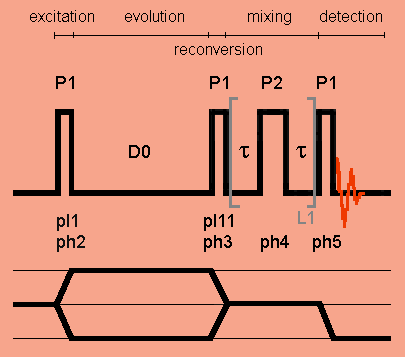
rfdr: 2D spin diffusion RFDR pulse program for TopSpin2.1

Since non-phase cycling is applied to the excitation P1 pulse, two-phase cycling for the reconversion P1 pulse is applied for filtering SQ coherences, and two-phase cycling is applied to the detection pulse P1 for selecting the 0Q -> -1Q coherence order jump.
;rfdr (TopSpin 2.1)
;2D exchange NMR in rotating solids
;rotor synchronized, set cnst31=spin rate, spin rate regulation recommended
;see Bennet, Ok, Griffin, Vega J. Chem. Phys. 98, 8624 (1992)
;written by HF, 16.9.98 modified by HF 21.5.07
;use TPPI for transform, phases will be dispersive
;Avance III version
;parameters:
;d1 : recycle delay
;d0 : =1u, t1 evolution period
;in0 : = 1/swh{F1}
;pl1 : X power level
;pl11 : power level for X pulses
;p1 : X 90 degree pulse
;p2 : X 180 degree pulse
;l1 : number of rotor cycles for mixing time
;$COMMENT=exchange NMR (RFDR) in rotating solids, rotor synchronized
;$CLASS=Solids
;$DIM=2D
;$TYPE=direct excitation
;$SUBTYPE=homonuclear correlation
;$OWNER=Bruker
define delay tau
"tau=0.5s/cnst31-p2/2"
"d31=1s/cnst31"
define delay mix
"mix=l1*d31"
;cnst11 : to adjust t=0 for acquisition, if digmod = baseopt
"acqt0=1u*cnst11"
"in0=inf1"
1 ze
#include <rot_prot.incl>
;protect for too slow rotation
mix
2 d31
d1 rpp4 ;recycle delay,
;reset the phase ph4 pointer to the first element
(p1 pl1 ph2):f1 ;90° excitation pulse
d0 ;evolution period
(p1 pl11 ph3):f1 ;90° reconversion pulse
5 tau ;mixing period with Gullion sequence
;tau = half rotor period - p2/2
(p2 ph4^):f1 ;180° pulse, increment phase ph4 pointer
tau ;tau = half rotor period - p2/2
lo to 5 times l1 ;set l1 for desired mixing period
(p1 ph5):f1 ;90° detection pulse
go=2 ph31
10m mc #0 to 2 F1PH(ip2,id0)
;delay for disk I/O, store signal,
;increase FID number,
;delete memory data,
;do not perform dummy scans
;with next acquisition,
;increment ph2 phase by 90° for TPPI procedure,
;increment time d0 by in0,
;loop to 2, td times for 2D experiment
HaltAcqu, 1m
6 exit
ph2= 0
ph3= 0 0 0 0 2 2 2 2
ph4= 0 1 0 1 1 0 1 0 ;X Y X Y Y X Y X compensated echo sequence of Gullion et al.
ph5= 0 0 0 0 0 0 0 0
2 2 2 2 2 2 2 2
ph31=0 2 2 0 2 0 0 2
2 0 0 2 0 2 2 0